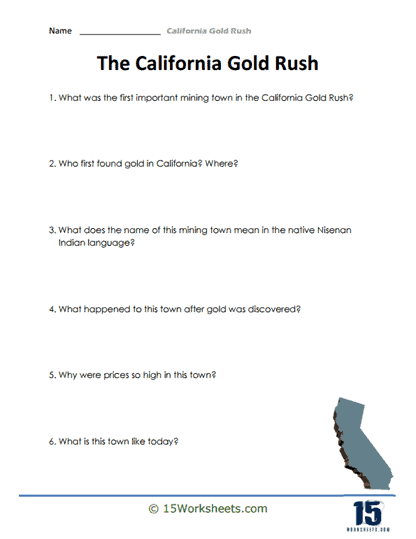Discovering Gold

Worksheet Description
The worksheet jumps into the specifics of the monumental gold discovery event in California’s history. It directs students to explore details surrounding the primary mining town associated with the Gold Rush, such as its historical significance, the individuals credited with the gold discovery, and the implications of this find on the town’s socio-economic fabric. Additionally, it prompts students to investigate the meaning of the town’s name in the native Nisenan Indian language and evaluate its contemporary status and the reasons behind its historically high prices.
To effectively tackle this worksheet, students should commence by researching the California Gold Rush’s historical narrative, emphasizing the first significant mining town. Utilizing reliable sources, such as history books, scholarly articles, and documentaries, they can gather answers about who discovered the gold, where it was found, and the repercussions on the town’s economy and population. Additionally, a closer look at linguistic sources or collaborations with cultural institutions might provide insights into the Nisenan Indian language and the town’s name’s meaning. A contemporary analysis, possibly through recent articles or travel logs, can shed light on the town’s present-day condition.
This worksheet is designed to instill a deeper understanding of the California Gold Rush’s multifaceted nature in students. Beyond merely recognizing it as a significant gold discovery event, the worksheet seeks to acquaint students with the social, economic, and cultural nuances that defined this historical period. By exploring the rise, challenges, and legacy of the central mining town, students learn to appreciate the broader implications of historical events. Moreover, by linking past events with their present-day ramifications, the worksheet underscores the lasting impact of history on modern society.
